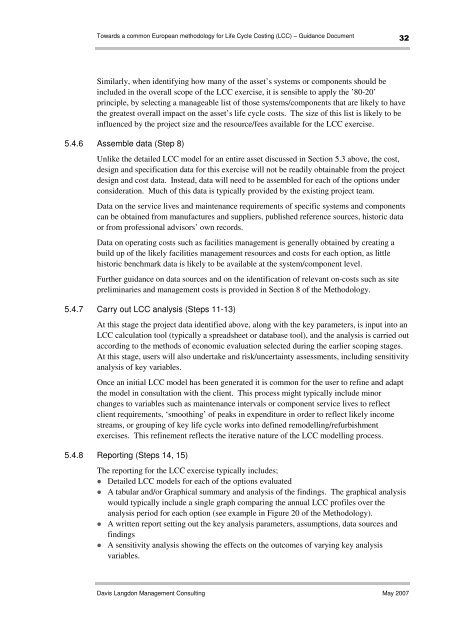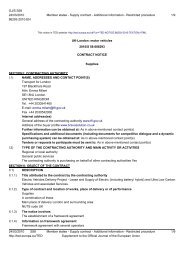Life cycle costing (LCC) as a contribution to sustainable construction ...
Life cycle costing (LCC) as a contribution to sustainable construction ...
Life cycle costing (LCC) as a contribution to sustainable construction ...
Create successful ePaper yourself
Turn your PDF publications into a flip-book with our unique Google optimized e-Paper software.
Towards a common European methodology for <strong>Life</strong> Cycle Costing (<strong>LCC</strong>) – Guidance Document<br />
32<br />
Similarly, when identifying how many of the <strong>as</strong>set’s systems or components should be<br />
included in the overall scope of the <strong>LCC</strong> exercise, it is sensible <strong>to</strong> apply the ’80-20’<br />
principle, by selecting a manageable list of those systems/components that are likely <strong>to</strong> have<br />
the greatest overall impact on the <strong>as</strong>set’s life <strong>cycle</strong> costs. The size of this list is likely <strong>to</strong> be<br />
influenced by the project size and the resource/fees available for the <strong>LCC</strong> exercise.<br />
5.4.6 Assemble data (Step 8)<br />
Unlike the detailed <strong>LCC</strong> model for an entire <strong>as</strong>set discussed in Section 5.3 above, the cost,<br />
design and specification data for this exercise will not be readily obtainable from the project<br />
design and cost data. Instead, data will need <strong>to</strong> be <strong>as</strong>sembled for each of the options under<br />
consideration. Much of this data is typically provided by the existing project team.<br />
Data on the service lives and maintenance requirements of specific systems and components<br />
can be obtained from manufactures and suppliers, published reference sources, his<strong>to</strong>ric data<br />
or from professional advisors’ own records.<br />
Data on operating costs such <strong>as</strong> facilities management is generally obtained by creating a<br />
build up of the likely facilities management resources and costs for each option, <strong>as</strong> little<br />
his<strong>to</strong>ric benchmark data is likely <strong>to</strong> be available at the system/component level.<br />
Further guidance on data sources and on the identification of relevant on-costs such <strong>as</strong> site<br />
preliminaries and management costs is provided in Section 8 of the Methodology.<br />
5.4.7 Carry out <strong>LCC</strong> analysis (Steps 11-13)<br />
At this stage the project data identified above, along with the key parameters, is input in<strong>to</strong> an<br />
<strong>LCC</strong> calculation <strong>to</strong>ol (typically a spreadsheet or datab<strong>as</strong>e <strong>to</strong>ol), and the analysis is carried out<br />
according <strong>to</strong> the methods of economic evaluation selected during the earlier scoping stages.<br />
At this stage, users will also undertake and risk/uncertainty <strong>as</strong>sessments, including sensitivity<br />
analysis of key variables.<br />
Once an initial <strong>LCC</strong> model h<strong>as</strong> been generated it is common for the user <strong>to</strong> refine and adapt<br />
the model in consultation with the client. This process might typically include minor<br />
changes <strong>to</strong> variables such <strong>as</strong> maintenance intervals or component service lives <strong>to</strong> reflect<br />
client requirements, ‘smoothing’ of peaks in expenditure in order <strong>to</strong> reflect likely income<br />
streams, or grouping of key life <strong>cycle</strong> works in<strong>to</strong> defined remodelling/refurbishment<br />
exercises. This refinement reflects the iterative nature of the <strong>LCC</strong> modelling process.<br />
5.4.8 Reporting (Steps 14, 15)<br />
The reporting for the <strong>LCC</strong> exercise typically includes;<br />
Detailed <strong>LCC</strong> models for each of the options evaluated<br />
A tabular and/or Graphical summary and analysis of the findings. The graphical analysis<br />
would typically include a single graph comparing the annual <strong>LCC</strong> profiles over the<br />
analysis period for each option (see example in Figure 20 of the Methodology).<br />
A written report setting out the key analysis parameters, <strong>as</strong>sumptions, data sources and<br />
findings<br />
A sensitivity analysis showing the effects on the outcomes of varying key analysis<br />
variables.<br />
Davis Langdon Management Consulting May 2007







